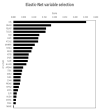Cerebrospinal Fluid Proteome Alterations Associated with Neuropsychiatric Symptoms in Cognitive Decline and Alzheimer's Disease
- PMID: 35326481
- PMCID: PMC8947516
- DOI: 10.3390/cells11061030
Cerebrospinal Fluid Proteome Alterations Associated with Neuropsychiatric Symptoms in Cognitive Decline and Alzheimer's Disease
Abstract
Although neuropsychiatric symptoms (NPS) are common and severely affect older people with cognitive decline, little is known about their underlying molecular mechanisms and relationships with Alzheimer’s disease (AD). The aim of this study was to identify and characterize cerebrospinal fluid (CSF) proteome alterations related to NPS. In a longitudinally followed-up cohort of subjects with normal cognition and patients with cognitive impairment (MCI and mild dementia) from a memory clinic setting, we quantified a panel of 790 proteins in CSF using an untargeted shotgun proteomic workflow. Regression models and pathway enrichment analysis were used to investigate protein alterations related to NPS, and to explore relationships with AD pathology and cognitive decline at follow-up visits. Regression analysis selected 27 CSF proteins associated with NPS. These associations were independent of the presence of cerebral AD pathology (defined as CSF p-tau181/Aβ1−42 > 0.0779, center cutoff). Gene ontology enrichment showed abundance alterations of proteins related to cell adhesion, immune response, and lipid metabolism, among others, in relation to NPS. Out of the selected proteins, three were associated with accelerated cognitive decline at follow-up visits after controlling for possible confounders. Specific CSF proteome alterations underlying NPS may both represent pathophysiological processes independent from AD and accelerate clinical disease progression.
Keywords: Alzheimer’s disease; cognitive decline; proteome.
Conflict of interest statement
J. Popp received consultation and speaker honoraria from Nestle Institute of Health Sciences, Innovation Campus, EPFL, Lausanne, Switzerland, Ono Pharma, OM Pharma Suisse and from Fujirebio Europe. L. Dayon is an employee of the Société des Produits Nestlé SA. G.L. Bowman is a former employee of the Société des Produits Nestlé SA. and recipient of NIH-National Institute on Aging funding, The other authors declare no potential conflict of interest.
Figures




Similar articles
-
Blood plasma protein profiles of neuropsychiatric symptoms and related cognitive decline in older people.J Neurochem. 2023 Jan;164(2):242-254. doi: 10.1111/jnc.15715. Epub 2022 Nov 15. J Neurochem. 2023. PMID: 36281546
-
Markers of neuroinflammation associated with Alzheimer's disease pathology in older adults.Brain Behav Immun. 2017 May;62:203-211. doi: 10.1016/j.bbi.2017.01.020. Epub 2017 Feb 1. Brain Behav Immun. 2017. PMID: 28161476
-
Cerebrospinal Fluid Correlates of Neuropsychiatric Symptoms in Patients with Alzheimer's Disease/Mild Cognitive Impairment: A Systematic Review.J Alzheimers Dis. 2019;71(2):477-501. doi: 10.3233/JAD-190365. J Alzheimers Dis. 2019. PMID: 31424398
-
Neuropsychiatric symptoms differently affect mild cognitive impairment and Alzheimer's disease patients: a retrospective observational study.Neurol Sci. 2019 Jul;40(7):1377-1382. doi: 10.1007/s10072-019-03840-4. Epub 2019 Mar 22. Neurol Sci. 2019. PMID: 30903419
-
Cerebrospinal fluid proteomics and biological heterogeneity in Alzheimer's disease: A literature review.Crit Rev Clin Lab Sci. 2020 Mar;57(2):86-98. doi: 10.1080/10408363.2019.1670613. Epub 2019 Nov 7. Crit Rev Clin Lab Sci. 2020. PMID: 31694431 Review.
Cited by
-
The promise of multi-omics approaches to discover biological alterations with clinical relevance in Alzheimer's disease.Front Aging Neurosci. 2022 Dec 7;14:1065904. doi: 10.3389/fnagi.2022.1065904. eCollection 2022. Front Aging Neurosci. 2022. PMID: 36570537 Free PMC article. Review.
-
Persisting neuropsychiatric symptoms, Alzheimer's disease, and cerebrospinal fluid cortisol and dehydroepiandrosterone sulfate.Alzheimers Res Ther. 2022 Dec 19;14(1):190. doi: 10.1186/s13195-022-01139-9. Alzheimers Res Ther. 2022. PMID: 36529757 Free PMC article.
-
Metabolomic Footprint of Disrupted Energetics and Amino Acid Metabolism in Neurodegenerative Diseases: Perspectives for Early Diagnosis and Monitoring of Therapy.Metabolites. 2023 Mar 1;13(3):369. doi: 10.3390/metabo13030369. Metabolites. 2023. PMID: 36984809 Free PMC article. Review.
-
Application of comprehensive geriatric assessment in oncology nursing: A literature review on optimizing treatment decisions and patient outcomes.World J Clin Oncol. 2025 Apr 24;16(4):104785. doi: 10.5306/wjco.v16.i4.104785. World J Clin Oncol. 2025. PMID: 40290689 Free PMC article. Review.
-
Neuropsychiatric symptoms in cognitive decline and Alzheimer's disease: biomarker discovery using plasma proteomics.J Neurol Neurosurg Psychiatry. 2025 Mar 24;96(4):370-382. doi: 10.1136/jnnp-2024-333819. J Neurol Neurosurg Psychiatry. 2025. PMID: 39288961 Free PMC article.
References
-
- Ismail Z., Smith E., Geda Y., Sultzer D., Brodaty H., Smith G., Agüera-Ortiz L., Sweet R., Miller D., Lyketsos C.G. Neuropsychiatric symptoms as early manifestations of emergent dementia: Provisional diagnostic criteria for mild behavioral impairment. Alzheimer’s Dement. 2015;12:195–202. doi: 10.1016/j.jalz.2015.05.017. - DOI - PMC - PubMed
-
- Steinberg M., Shao H., Zandi P., Lyketsos C., Welsh-Bohmer K., Norton M., Breitner C.S.J., Steffens C.D., Tschanz T.J. Point and 5-year period prevalence of neuropsychiatric symptoms in dementia: The Cache County Study. Int. J. Geriatr. Psychiatry. 2008;23:170–177. doi: 10.1002/gps.1858. - DOI - PMC - PubMed
Publication types
MeSH terms
Substances
Grants and funding
LinkOut - more resources
Full Text Sources
Medical

